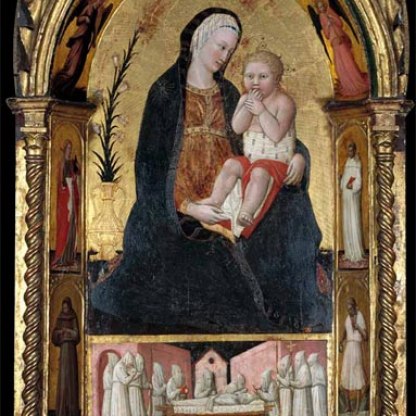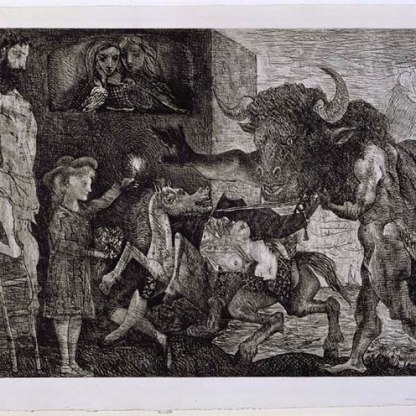L'Umana Fragilità (Human Frailty)

In 1655 a devastating plague swept Naples. Salvator Rosa's son, Rosalvo, his brother, his sister, her husband and five of their children, all died. The transience of human life was a recurring theme in seventeenth-century painting and thought, but for Rosa, in the year he made this painting, the subject had a tragic immediacy. A letter to his friend Ricciardi makes clear the effect this multiple bereavement had upon him: 'This time heaven has struck me in such a way that shows me that all human remedies are useless and the least pain I feel is when I tell you that I weep as I write.'
One can imagine him weeping as he painted L'Umana Fragilità.
Despite its universal, eternal theme – the frailty of human life – this is an intensely personal painting. The tired-looking, strangely passive seated woman is a portrait of Lucrezia, Salvator's mistress and the mother of Rosalvo. The child, his wrist clasped by Death, represents the artist's dead son. The ring of pale roses around the mother's head is probably an allusion to the family name. Salvator's own initials appear at the very bottom of the canvas, on the blade of the knife, a death symbol, the ruthless steel that has severed his family from him.
Emerging from the thick, nocturnal gloom that surrounds the human figures, a huge winged skeleton directs the infant's wrist as he writes:
Conceptio Culpa, Nasci Pena, Labor Vita, Necesse Mori – 'Conception is a sin, Birth is pain, Life is toil, Death a necessity'
The viewer does not however really need any knowledge of Latin to decipher this bleak message. For mother and child are surrounded by a host of mementos mori, symbols that remind the viewer that to be human is to be mortal.
Some of these symbols, though perhaps not used in quite the same way today, are relatively easy to decipher. The bubbles blown by the child at the bottom left, for instance, suggest the brevity of human existence. Homo est bulla – 'man is but a bubble' – was a well-known phrase of the day.
Other symbols are more obscure. At the left edge of the painting, a stone obelisk has five emblems carved upon it. These are explained in an influential seventeenth-century book, The Hieroglyphica by Piero Valeriano, an early copy of which is in the Fitzwilliam library. The page dealing with obelisks like that depicted by Rosa can be seen, right.
The two faces at the top, that of a child and an old man, are straightforward references to the human life-span. Beneath the old man is a falcon that, Valeriano tells us, represents the vitality of life. Significantly, in Rosa's painting, this is obscured by the wing of the skeleton. The fish beneath this is a symbol of hatred and death. The dog-like creature at the bottom is in fact a hippopotamus and represents 'the violence and discord with which man ends his days'.
The painting rewards long contemplation, not just because of the seriousness of the message and the profusion of symbols, but because details actually seem to emerge from the gloom the longer one gazes at it. The serious stone face of the statue at the right, for instance, picked out with a few neat, light brushstrokes, could easily be overlooked. This is Terminus, a Roman god of death. He also appears in a print by Rosa in the Fitzwilliam, right. Here we see the Greek philosopher Democritus, meditating amid ruins, and surrounded by other objects symbolising man's mortal state.
It is rather surprising, when we approach him via this bleak and macabre image, to learn that Salvator Rosa was in fact a distinguished comic actor, a satirist and poet, a composer and a bon viveur known for his good humour and practical jokes, whose house had been described as 'an abode of mirth and the marketplace of gaiety'.
In fact the anecdotal details of this remarkable man's life add to the poignancy and seriousness of this work.
Themes and periods
Data from our collections database
Cardinal Flavio Chigi (c. 1630-93), Rome; presumably in the possession of the Chigi family until an unknown date before 1824; John, 2nd Lord Northwick (1770-1859); Northwick sale, Christie's, 20 May 1838 (114), bt. in; Northwick sale, Thirlestane House, Cheltenham, Philips, 26 July 1859 (1120), bt. Agnew; sold by Messrs Thomas Agnew, London, to R.C. Fergusson, August 1859; descended to his grandson-in-law, Lt.-Col. Wallace Cunninghame, D.S.O.; his sale, Christie's, 7 March 1958 (28), bt. Messrs Knoedler London
Acquisition and important dates
- Method of acquisition: Bought
- Dates: 1958
Dating
- 1650s
- Production date: circa AD 1656
Maker(s)
- Rosa, Salvator Painter
Materials used in production
Read more about this recordAudio description
Other highlight objects you might like
Suggested Curating Cambridge products
Human Frailty - Art print
£30.00

Bouquets - Notecard pack
£6.00

Sign up to our emails
Be the first to hear about our news, exhibitions, events and more…



